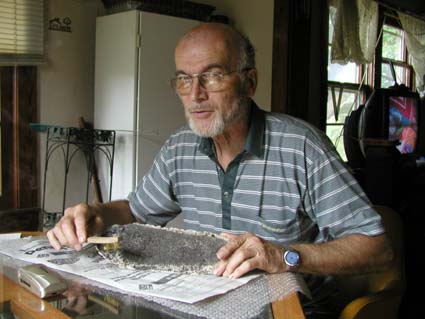No, you did read it right. The scientists that were leading the expedition into the Siberian taiga claim that although they had to cancel their expedition due to the recent forest fires, they have concluded that because of the fires, the bears and yetis are fighting for territory…
Hold on…I need some coffee before continuing this story. It’s too much….OK, I’m back. *sips*
Expedition leader, Igor Burtsev had the following to say:
“They make strange pyramidal constructions of trunks and branches in the wood – sometimes 3 or 4 meters, sometimes only 30 cm high. Sometimes they bend huge trees and twist their trunks like wheels. A human being is just not strong enough for that, and there seems to be no need for bears to do this. At first, we thought that yetis do this to make shelters, but then we came to the conclusion that this is a sort of landmark for them. Or, maybe, this is a way for a yeti to say something to its congeners.”
Although these are outlandish claims made by Mr. Burtsev, he did not present any evidence to prove his claims. I have heard of “Bigfoot nests” that are made by nomadic Bigfoots (if you can believe that) but stating to the press that you think that bears and yetis are on a full-out war is kinda presumptuous, don’t you think?
This story is an update from a post I did a few weeks ago.
|
Oct 11, 2010 17:15 Moscow Time
|

Full source: Ruvr.ru
3 commentsAn expedition that was looking for the mysterious yeti in Mountain Shoria – a faraway region in the Siberian taiga – has recently returned home. The expedition’s members claim that the forest fires of this extremely hot summer made Altai yetis move to the Kuzbass region, where they have started a “war” with local bears.
Searches for this mysterious creature, also known as “bigfoot” or “snowman”, started several decades ago. People look for yetis – or, at least, their traces – elsewhere: in Canada, Europe, Mongolia, Azerbaijan, Tajikistan and Russia. Several times, yetis’ traces have been found – footsteps that resemble that of humans but are too big for a man, flocks of hair or gigantic branch shelters in forests. In 1967, a certain Roger Patterson even filmed a yeti in northern California, but experts still argue whether this shooting is real or fake.
This year’s expedition to Mountain Shoria is already the third. One of its participants, the director of the International Center for Hominology Igor Burtsev assures that yetis leave traces of their stay in the taiga and fight with local bears.
“They make strange pyramidal constructions of trunks and branches in the wood – sometimes 3 or 4 meters, sometimes only 30 cm high. Sometimes they bend huge trees and twist their trunks like wheels. A human being is just not strong enough for that, and there seems to be no need for bears to do this. At first, we thought that yetis do this to make shelters, but then we came to the conclusion that this is a sort of landmark for them. Or, maybe, this is a way for a yeti to say something to its congeners.”
Igor Burtsev has talked with local residents who claim that they have seen yetis with their own eyes. Sometimes, farmers take them for wood goblins.
“Folk beliefs say that the wood goblin is the master of the woods. All animals, even bears, submit to him. The wood goblin has a strong hypnotic power, thus he is not afraid of any animal.”
Scientists think that these ancient beliefs do have some grounding – it seems that today yetis in Siberia are competing with bears, and the yetis are winning – they are obviously stronger and have rudimentary intellect. If this “war” between yetis and bears continues, there is a risk that bears will not sleep this winter because of a shortage of food, instead going to villages in search of something to eat. To prevent this, the region’s authorities plan to organize bear feeding. However, it seems that local residents have already found a common language with the yetis – they leave candies for them and communicate with them mentally – yetis are believed to be telepathic. Igor Burtsev even claims that to a certain extent, yetis can imitate the human language. “I would, without doubt, call the yeti another species of man,” he says.





